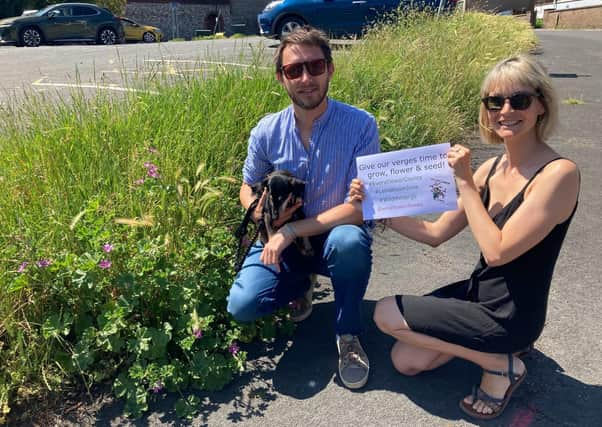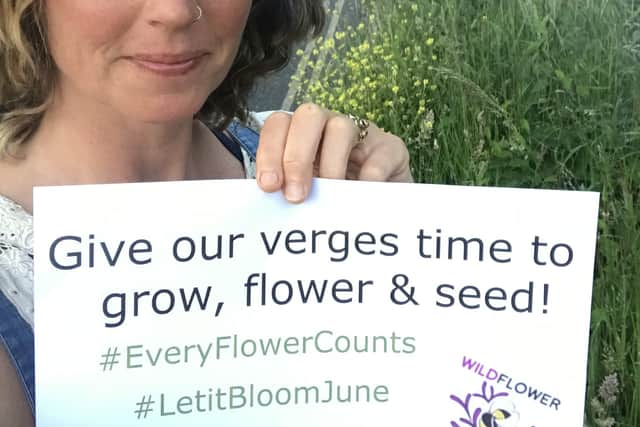Calls for ‘wildlife’ designation for all of Lewes’ green verges


Wildflower Lewes said it was in conversation with councillors about the proposal.
There are currently 176 designated ‘wildlife verges’ in East Sussex, totalling more than 125 miles – the approximate distance from Lewes to Cambridge.
Advertisement
Hide AdAdvertisement
Hide AdIdentified by a small, yellow, flower-shaped sign, wildlife verges in the county have been very successful so far.


A rare Lizard orchid has been found growing on a site in Lewes – and one East Sussex verge contains 68 per cent of the UK population of Spiked Rampion.
These verges are usually only cut once a year and not at all between the beginning of March and the end of August.
The group wants to see all of the town’s verges re-classified as wildlife verges.
Advertisement
Hide AdAdvertisement
Hide Ad“Visibility cuts would still take place and a single autumn cut with the clippings removed would create the perfect conditions for wildflowers,” the spokesman said.


According to Wildflower Lewes, 97 per cent of our wildflower meadows have been lost nationwide since the 1970s, with devastating knock-on effects on the insects that depend on them and the animals that depend on the insects.
“We’d like to do our bit in Lewes to stem this loss by cultivating more wildflower patches across the town, creating “stepping stones” that join up isolated habitat,” the spokesman said.
“We’d also like people in the town to have wildflowers to enjoy near their homes, and have a chance to get involved in looking after the nature on their doorstep.”
Advertisement
Hide AdAdvertisement
Hide AdThe group also stressed the importance of safety and of verges not restricting access for pedestrians.
“We believe that road safety is of paramount importance,” the spokesman said.
“We fully support visibility cuts at key areas to ensure road safety and people must be able to access the town easily. “Luckily there are many verges that are safe to leave to grow in the summer.
“We understand it’s a big mindset change where the norm is a tidy, clipped grass.
Advertisement
Hide AdAdvertisement
Hide Ad“But wildflower areas can be a feast for the eyes if we can just embrace them, and they provide important habitats for all kinds of creatures.”
However East Sussex County Council said it was ‘not possible’ to declare all verges wildlife verges.
“Wildlife verges are of special ecological interest supporting rare or vulnerable species and habitats and this would not be the case for every verge,” a spokesman said.
“In addition the council has a statutory duty to cut verges for safety reasons and to ensure visibility for road users.
Advertisement
Hide AdAdvertisement
Hide Ad“Residents can apply for a verge to be considered a wildlife verge via the East Sussex Highways website.”
June campaign
Wildflower Lewes recently ran a campaign to try and change the way that Lewes’ urban verges were cut.
Urban verges are currently chopped twice a year and the group was left ‘devastated’ to learn that the first cut was scheduled for the end of June – just when wildflowers are blooming.
Campaign coordinator Natasha Padbury said: “This is the worst time of the year to do the work.
Advertisement
Hide AdAdvertisement
Hide Ad“Our verges need the summer to grow, flower and seed if they are to flourish.
“We are in a biodiversity crisis – now is the time to harness every green space we can to create wildlife havens that support invertebrates and nature we can enjoy on our doorstep.”
As part of the campaign, residents were encouraged to post photos of themselves on social media next to their local pre-cut, flowery verge holding a campaign poster.
East Sussex County Council confirmed the urban verges were cut as planned at the end of June.
Advertisement
Hide AdAdvertisement
Hide AdA spokesman said: “East Sussex Highways currently cuts urban verges twice a year, unless the parish or town council have an agreement in place for more cuts.
“If a verge has been declared a wildlife verge it will be cut just once a year and not at all between the beginning of March and the end of August.
“The council is also currently carrying out a rural grass cutting trial and verges in 12 parishes across the county will be cut just once this year to help create more wildlife corridors.”
Find out more about the rural grass cutting trial, or provide feedback, at the council website here.